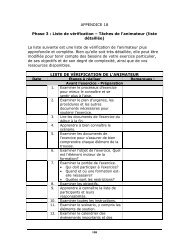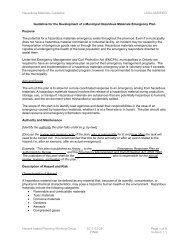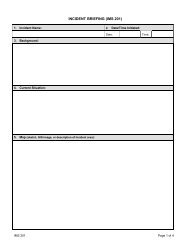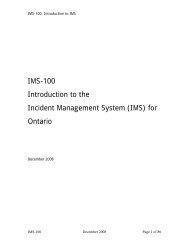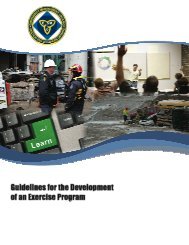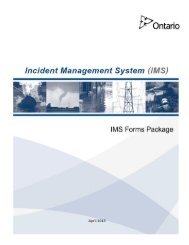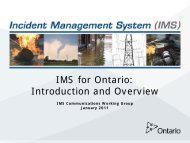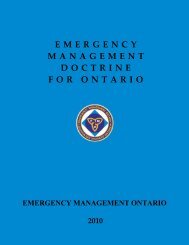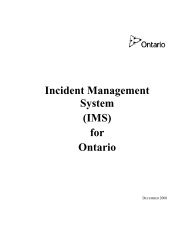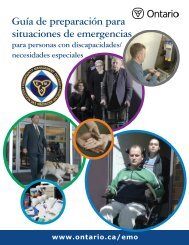Energy
PDF Version - Emergency Management Ontario
PDF Version - Emergency Management Ontario
- No tags were found...
You also want an ePaper? Increase the reach of your titles
YUMPU automatically turns print PDFs into web optimized ePapers that Google loves.
Ontario Government Emergency Fuel Distribution Protocol<br />
Appendix A - Critical Infrastructure Sectors<br />
EMO has identified nine critical infrastructure sectors. The PEOC/EMO has not pre-determined the priority<br />
of these nine CI sectors. Depending on the nature of the emergency, priority will be determined at an appropriate<br />
time during a declared provincial emergency by strategic assessment<br />
C o n t i n u i t y o f G o v e r n m e n t<br />
(municipal, provincial and federal governments).<br />
Oil and Natural Gas (oil refineries,<br />
distribution and retail operations; natural<br />
gas distribution).<br />
Electricity (nuclear, hydroelectric and<br />
fossil power generation; electricity<br />
transmission and distribution).<br />
Financial Institutions (Bank of Canada,<br />
banks and trust companies, credit<br />
unions, caisses populaires, Province<br />
of Ontario Savings Office, interinstitution<br />
computer systems, insurance<br />
companies, mutual fund companies,<br />
stock exchanges).<br />
Food and Water (water treatment,<br />
water storage, water monitoring, water<br />
distribution, waste water and sewage<br />
treatment, food production and harvesting,<br />
food processing and distribution,<br />
food inspection and monitoring).<br />
Health (hospitals, ambulance services,<br />
pharmaceuticals, blood services,<br />
and long-term care facilities).<br />
Public Safety and Security (fire<br />
fighting, police and emergency medical<br />
services, emergency operations<br />
and evacuation centres, Centre of Forensic<br />
Sciences, Office of the Chief<br />
Coroner, military facilities, correctional<br />
facilities, search and rescue, flood and<br />
erosion control, pollution monitoring<br />
and public alerting, weather forecasting<br />
and public alerting);<br />
Telecommunications (9-1-1 communications,<br />
telephones, wireless telephones,<br />
pagers, television stations,<br />
radio stations, internet); and<br />
Transportation (highways and<br />
roads, snow removal services, railways,<br />
public transit, airports, aviation<br />
communication and navigation, port<br />
facilities, canals and shipping locks,<br />
movable bridge systems, ferries, marine<br />
communication and navigation,<br />
border controls);<br />
The preceding list is in alphabetical order and not in prioritized order. Nevertheless, it is recognized that most<br />
of the CI sectors will be unable to operate without an ongoing supply of fuel. The list is a generic guide only<br />
and not intended to provide a complete and exhaustive description of all possible essential users in each CI<br />
sector.<br />
6



